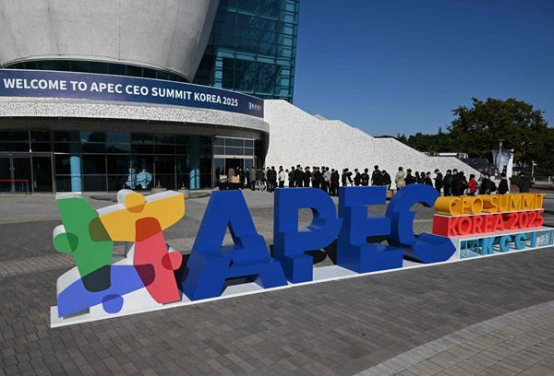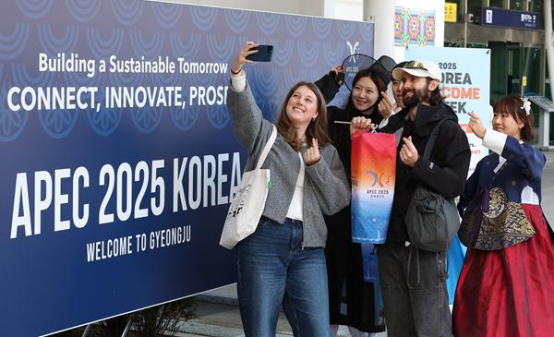
On October 28, 2025, people queue to enter the Gyeongju Arts Center in Gyeongju, South Korea, the main venue for the APEC CEO Summit Korea 2025. (Image/VCG)
The 32nd APEC Economic Leaders’ Meeting was held in Gyeongju, South Korea, from October 31 to November 1. Under the theme “Building a Sustainable Tomorrow: Connect, Innovate, Prosper”, the summit focused on topics such as artificial intelligence, digital economy, and population aging, aiming to foster more inclusive, open, and resilient Asia-Pacific cooperation. Youth representatives from across the Asia-Pacific region expressed their anticipation for the APEC summit to reporters of China Youth Daily and China Youth Network. Their focus extends beyond APEC cooperation itself to the “new opportunities” that young people can seize amidst the wave of AI.
Youth Perspective: From Connection to Co-creation
Wu Jinghui, Vice Chairman of the Global New Generation Chinese Alliance and Vice Chairman of the Representative Office of China Council for the Promotion of International Trade in Australia, believes that the theme of this APEC summit represents the call of our times to youth. “Our generation stands at a critical juncture where the technological revolution converges with globalization: on one hand, we are witnessing the tremendous opportunities brought by artificial intelligence (AI), digital economy, and green transition; on the other hand, we bear the responsibility to drive inclusive growth and transnational collaboration.”
In his view, the “connectivity” emphasized by APEC extends beyond state-to-state exchanges to the deep integration of industries, talent, data, and culture. AI serves as the core force enabling this very “connectivity”. Wu noted, “In the past, businesses expanding globally relied heavily on personal networks and channels. Today, AI empowers enterprises to gain insights into overseas markets from their home base, enabling precise marketing and intelligent decision-making.”
For many young people in the Asia-Pacific region, APEC is not a distant diplomatic arena but a cooperation mechanism closely linked to their daily lives. Nguyen Thi Thanh Thanh, a Vietnamese youth who previously studied in China and now works as an independent content creator, told China Youth Daily and China Youth Network reporter: “APEC is actually all around us — it ensures the freshness of fruit on our tables, powers the brighter city lights, enables young people to make cross-border purchases with their smartphones, and allows us to travel abroad to experience diverse cultures. These are all tangible outcomes of enhanced connectivity.”
Nguyen Thi Thanh Thanh was deeply impressed by this year’s APEC theme. “Connectivity means breaking down barriers—whether in infrastructure links, goods transport, or people-to-people exchanges. Innovation focuses more on advances in AI and digital technologies. Prosperity is about ensuring that the fruits of development benefit everyone and promote more balanced and inclusive growth.” She emphasized that connectivity drives innovation, and together they generate prosperity, which in turn fuels further innovation. To achieve this virtuous cycle, she concluded, connectivity serves as the essential foundation.
From a youth perspective, APEC’s significance has long transcended mere economic cooperation. Chinese youth Yao Siran still clearly remembers the “APEC Blue” during the Beijing APEC Summit in November 2014. “The sky was exceptionally clear in Beijing at that time — I even shared photos of the beautiful weather on my WeChat Moments. Since then, ‘APEC Blue’ became a catchphrase shared by everyone,” she remarked. Reflecting on the past decade, she noted how blue skies have now become a regular feature of daily life. In her view, the evolution from “APEC Blue” to continuously deepening regional cooperation and increasingly close economic exchanges reflects the expansion and upgrading of the ethos of openness and mutual benefit between China and the wider Asia-Pacific region.

On October 26, 2025, people take selfies after arriving at Gyeongju, South Korea. The 32nd APEC Economic Leaders’ Meeting was held here from October 31 to November 1. (Image/VCG)
Youth Opportunity: AI-powered Regional Cooperation
"Why was APEC held in Gyeongju? Development outcomes cannot be measured by numbers alone; the key is who benefits.” This statement from the official e-government website of North Gyeongsang Province, South Korea, has resonated deeply with many young people. The youth interviewees widely expressed hope that the “inclusive growth” championed by the summit will further expand their economic participation and extend the benefits of innovation to broader segments of society.
Wu Jinghui emphasized that in today’s complex and volatile global landscape, the importance of youth exchange and cooperation has become increasingly prominent. He stated that APEC provides a platform for young people characterized by openness, equality, and co-creation. He expressed his anticipation for deeper collaboration among Asia-Pacific youth across three key dimensions: “Smart, Green, and Open.” This includes jointly advancing AI-driven social innovation projects—such as smart agriculture, sustainable cities, digital education, and cross-border e-commerce—to establish AI as a new engine for enhancing connectivity and sustainable development.
"‘Connect, Innovate, Prosper’ is not merely the summit’s theme but a guiding principle for our generation’s actions,” stated Wu Jinghui. As a young entrepreneur deeply engaged in international trade and AI globalization, he speaks from firsthand experience about technology’s power to transform destinies. “We must ensure AI transcends laboratory boundaries to enter factories, classrooms, and rural communities; we must make innovation a shared language for all Asia-Pacific youth, not an exclusive privilege of developed economies. Only through connectivity can we achieve shared success; only through innovation can we attain lasting prosperity.”
Wu Jinghui shared that his team is currently exploring the use of AI to empower Sino-Australian business collaboration. “We utilize Generative Engine Optimization (GEO) and AI marketing systems to help Chinese domestic enterprises and Australian brands accurately connect with international markets. Leveraging AI algorithms and big data analytics, we can rapidly understand the consumption habits and cultural preferences of different countries, enabling intelligent product selection and targeted promotion.” In his view, this new technology is reshaping the entrepreneurial ecosystem. Whereas a cross-border e-commerce team once required over a dozen people to manage a website matrix, a young entrepreneur can now manage multiple websites single-handedly with AI assistance. AI is significantly lowering the barriers to global expansion, making innovation more inclusive and widely accessible.
The Asia-Pacific region has long been recognized as the primary “engine of growth” for the global economy. Xu Liping, a senior researcher at the Chinese Academy of Social Sciences’ National Institute of International Strategy, highlighted that the region’s vitality is closely linked to its substantial youth population, strong innovative drive, and highly complementary economies. In recent years, the rise of digital economy has further emerged as a new dynamic force for regional development, significantly amplifying the role of youth in advancing connectivity and fostering innovation across the region. Donald Bruce Dingwell, President of the European Academy of Sciences and a foreign academician of the Chinese Academy of Sciences, recently stated at the 2025 World Young Scientist Summit: “The era of science being conducted in isolation is over. Future progress depends on our capacity for collaboration. We must commit to dismantling the barriers that hinder the free flow of ideas, data, and talent.”
The “Global AI Young Scientists: Distribution and Mobility Report (2025),” released by the Institute of Scientific and Technical Information of China (ISTI), reveals that nearly 60% of young scientists in the global AI field are distributed across China and the United States. Additionally, the scale of bilateral talent flow between China and countries such as Australia and Singapore continues to expand. Such cross-border exchanges of young S&T talent are becoming a vital component of the regional innovation ecosystem.
Youth Mission: Shaping the Future through Collaboration
Over the past three decades of its development, APEC has consistently mirrored the transformation of the Asia-Pacific region and the trajectory of its youth—from promoting trade liberalization to advancing digital economy cooperation. Today, AI, the green transition, and enhanced connectivity are emerging as the new pillars of regional collaboration. For the young people of the Asia-Pacific region, this represents not only a horizon of opportunities but also a shared responsibility.
In Yao Siran’s view, young people bear a unique mission in regional cooperation: to ignite growth through innovation and shape the future through collaboration. She contends that in our complex world, Asia-Pacific youth should focus more on addressing genuine societal needs—from education and healthcare to environmental protection and accessibility—and consider how AI and digital economy can enhance lives. Furthermore, she emphasized the critical importance of cross-cultural collaboration: “Youth must proactively embrace diverse perspectives, engage with people from different backgrounds, and integrate technological thinking with humanistic concern. This aligns perfectly with the spirit of openness, inclusiveness, and shared success that APEC champions.”
Nguyen Thi Thanh Thanh observed that China possesses particularly rich experience in connectivity, providing a solid platform for Asia-Pacific youth to engage in regional cooperation—whether in infrastructure development, supply chain integration, industrial scale, policy coordination, technical standards, or financing capabilities. “Taking China and Vietnam as an example, the two countries are further enhancing the connectivity of their land and maritime transport networks through the joint development of the Belt and Road Initiative and the ‘Two Corridors, One Ring’ framework. This not only facilitates trade but also creates more opportunities for innovation and entrepreneurship. I look forward to breakthroughs in supply chain resilience and trade and investment at the summit, enabling ordinary people to experience tangible changes.”
Young people across the Asia-Pacific are writing a new chapter of cooperation and innovation in their own unique ways. They are developing algorithms in AI laboratories, promoting products on cross-border e-commerce platforms, and exploring sustainable solutions through social innovation projects. As Dingwell rightly stated, “Future progress depends on our capacity for collaboration.” The actions of these young pioneers serve as the most compelling testament to this very principle.